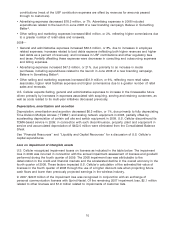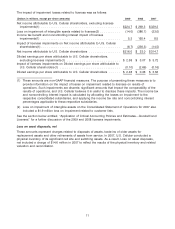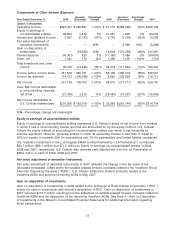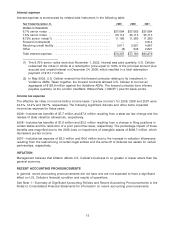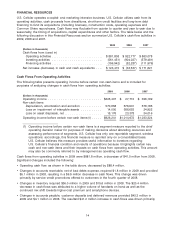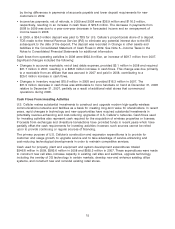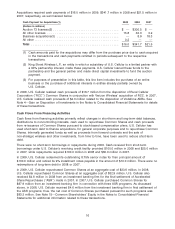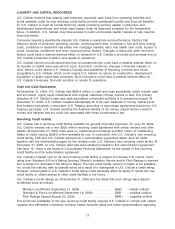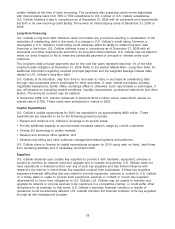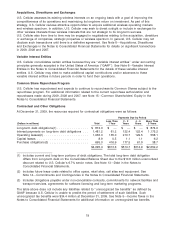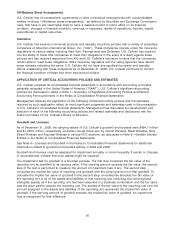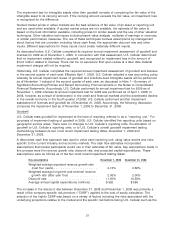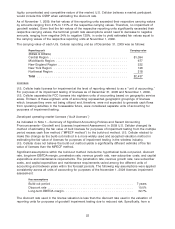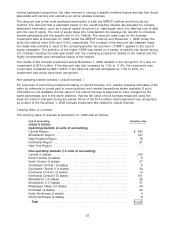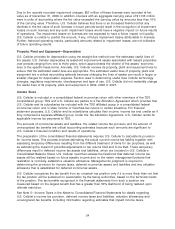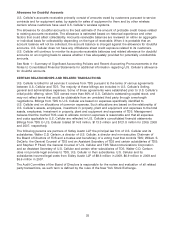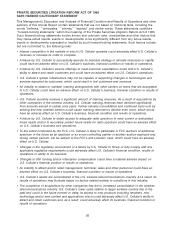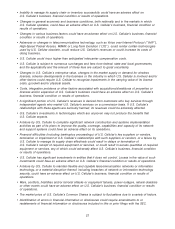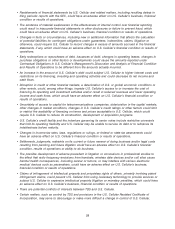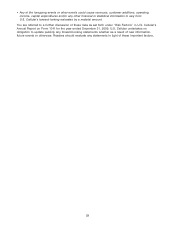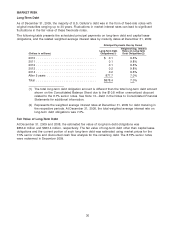US Cellular 2009 Annual Report Download - page 28
Download and view the complete annual report
Please find page 28 of the 2009 US Cellular annual report below. You can navigate through the pages in the report by either clicking on the pages listed below, or by using the keyword search tool below to find specific information within the annual report.Off-Balance Sheet Arrangements
U.S. Cellular has no transactions, agreements or other contractual arrangements with unconsolidated
entities involving ‘‘off-balance sheet arrangements,’’ as defined by Securities and Exchange Commission
rules, that have or are reasonably likely to have a material current or future effect on its financial
condition, changes in financial condition, revenues or expenses, results of operations, liquidity, capital
expenditures or capital resources.
Insurance
U.S. Cellular has several commercial property and casualty insurance policies with a variety of subsidiary
companies of American International Group, Inc. (‘‘AIG’’). These companies operate under the insurance
regulations of various states including New York, Pennsylvania and Delaware. U.S. Cellular has inquired
into the ability of these AIG companies to meet their obligations in the event of a claim against these
policies and has received assurance from AIG and U.S. Cellular’s insurance brokers that the companies
remain able to meet these obligations. State insurance regulators and the rating agencies have issued
press releases indicating the same. U.S. Cellular did not have any significant property and casualty
claims outstanding with these companies as of December 31, 2009. U.S. Cellular continues to monitor
the financial condition of these and other insurance providers.
APPLICATION OF CRITICAL ACCOUNTING POLICIES AND ESTIMATES
U.S. Cellular prepares its consolidated financial statements in accordance with accounting principles
generally accepted in the United States of America (‘‘GAAP’’). U.S. Cellular’s significant accounting
policies are discussed in detail in Note 1—Summary of Significant Accounting Policies and Recent
Accounting Pronouncements in the Notes to Consolidated Financial Statements.
Management believes the application of the following critical accounting policies and the estimates
required by such application reflect its most significant judgments and estimates used in the preparation
of U.S. Cellular’s consolidated financial statements. Management has discussed the development and
selection of each of the following accounting policies and related estimates and disclosures with the
Audit Committee of U.S. Cellular’s Board of Directors.
Goodwill and Licenses
As of December 31, 2009, the carrying values of U.S. Cellular’s goodwill and licenses were $494.7 million
and $1,435.0 million, respectively. Licenses include those won by Carroll Wireless, Barat Wireless, King
Street Wireless and Aquinas Wireless in various FCC auctions, as discussed in Note 6—Variable Interest
Entities in the Notes to Consolidated Financial Statements.
See Note 9—Licenses and Goodwill in the Notes to Consolidated Financial Statements for additional
information related to goodwill and licenses activity in 2009 and 2008.
Goodwill and licenses must be assessed for impairment annually or more frequently if events or changes
in circumstances indicate that such assets might be impaired.
The impairment test for goodwill is a two-step process. The first step compares the fair value of the
reporting unit as identified to its carrying value. If the carrying amount exceeds the fair value, the second
step of the test is performed to measure the amount of impairment loss, if any. The second step
compares the implied fair value of reporting unit goodwill with the carrying amount of that goodwill. To
calculate the implied fair value of goodwill in this second step, an enterprise allocates the fair value of
the reporting unit to all of the assets and liabilities of that reporting unit (including any unrecognized
intangible assets) as if the reporting unit had been acquired in a business combination and the fair value
was the price paid to acquire the reporting unit. The excess of the fair value of the reporting unit over the
amount assigned to the assets and liabilities of the reporting unit represents the implied fair value of
goodwill. If the carrying amount of goodwill exceeds the implied fair value of goodwill, an impairment
loss is recognized for that difference.
20


